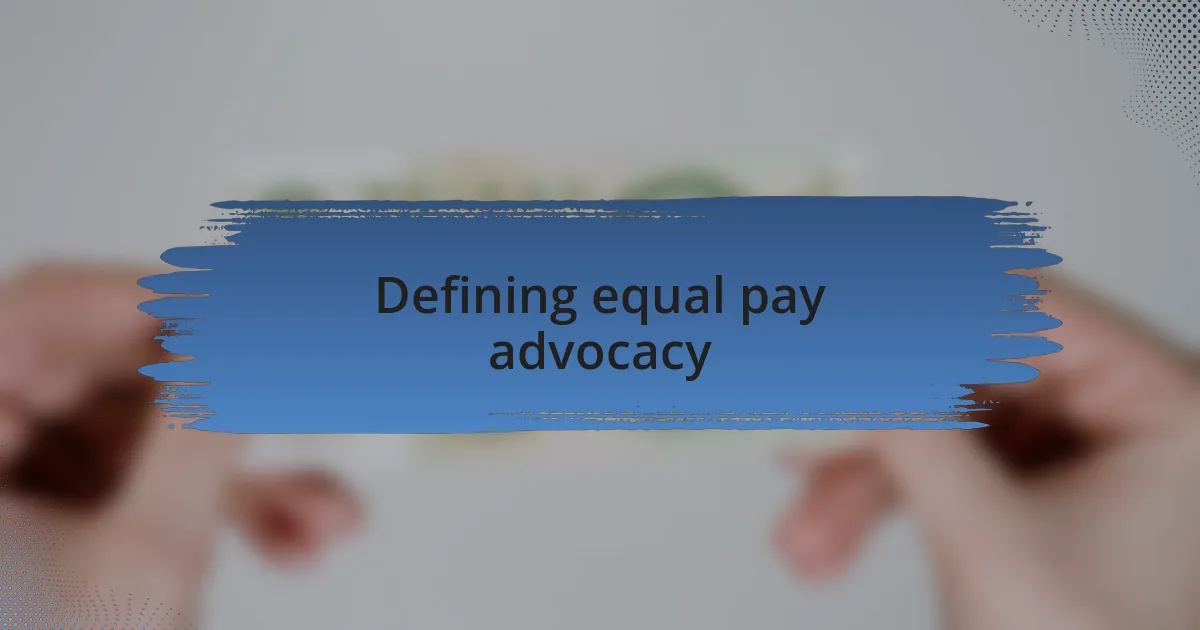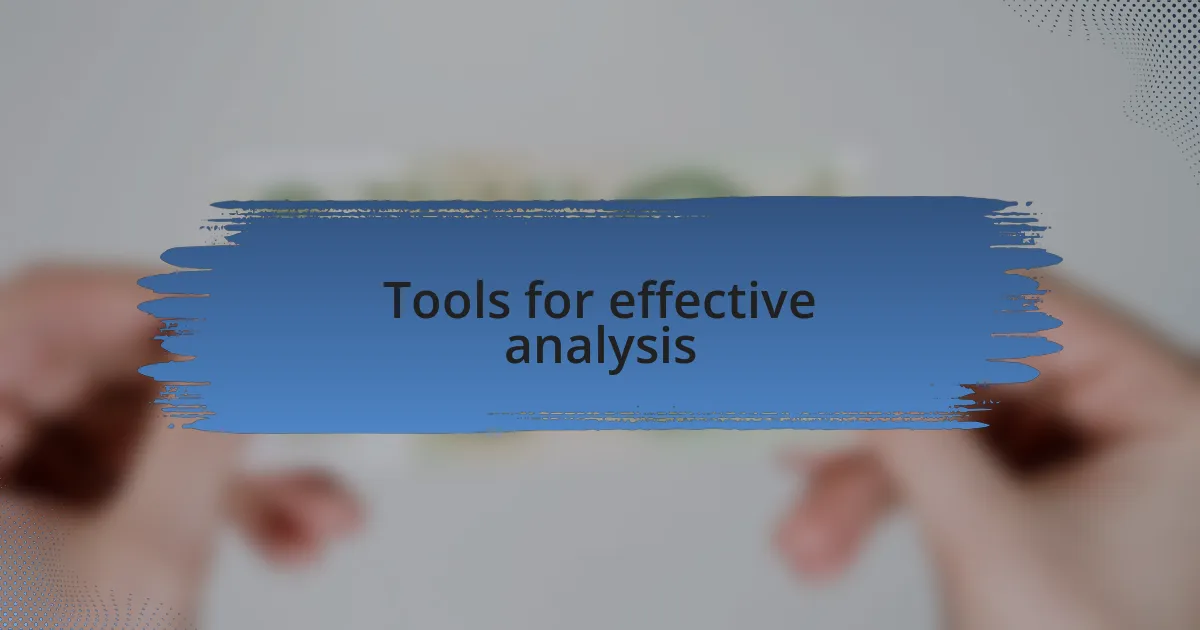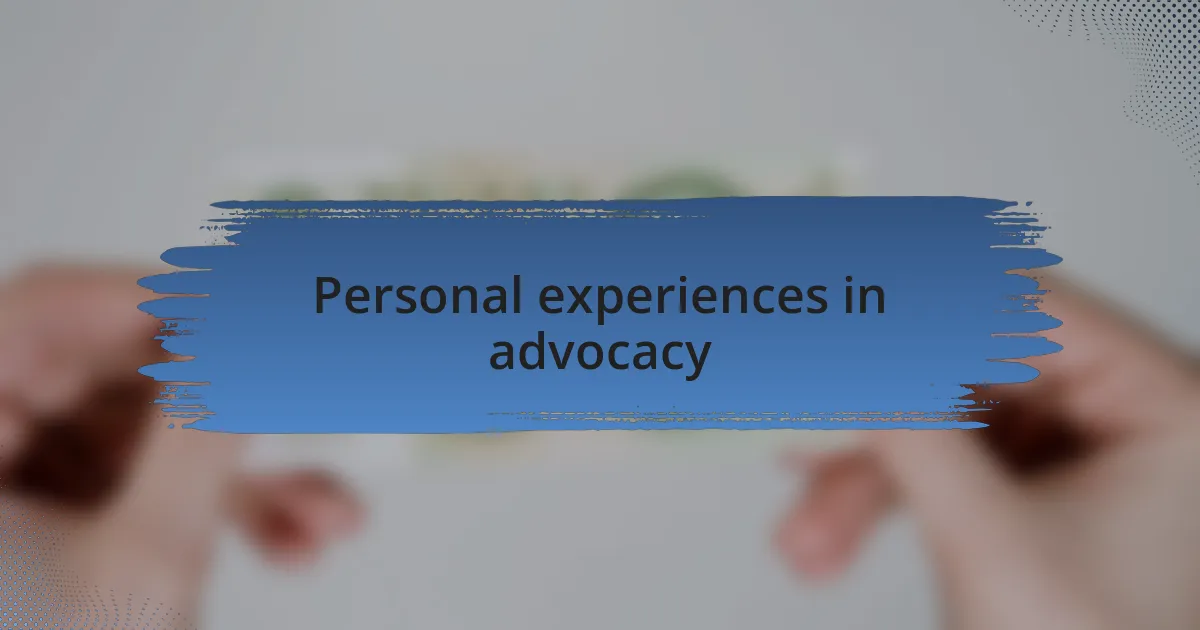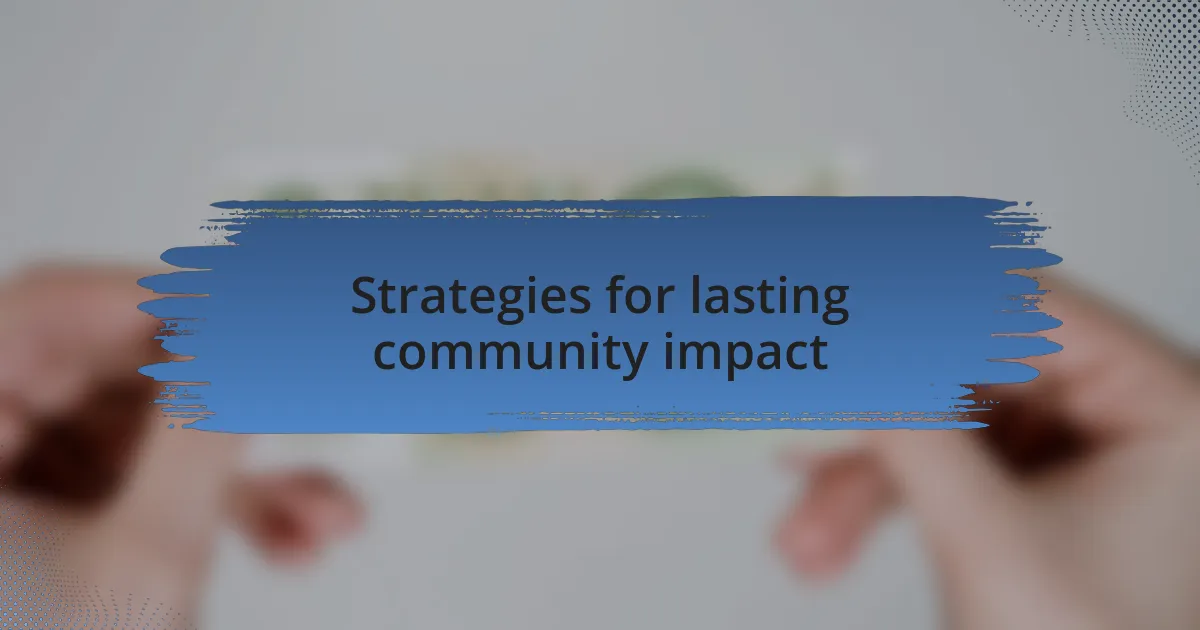Key takeaways:
- Community impact analysis reveals the interconnectedness of social, economic, and environmental factors, emphasizing the need to consider marginalized voices.
- Equal pay advocacy is essential for economic justice, aiming to close wage gaps that affect women’s financial security and societal well-being.
- Utilizing qualitative research and data visualization enhances understanding and drives impactful advocacy for equitable pay.
- Building relationships and integrating education into advocacy efforts empower communities and create lasting change.

Understanding community impact analysis
Community impact analysis is a vital tool for understanding how decisions and initiatives affect the people within a community. It examines the social, economic, and environmental consequences of policies or programs. When I first dived into this analysis for a local project, I was shocked to see just how intertwined these aspects are. Could one small decision really influence entire neighborhoods?
As I conducted my analysis, I began to realize that often overlooked voices, particularly those of marginalized groups, are essential to fully grasping the impact of any initiative. I remember attending a community meeting where a single mother’s perspective completely shifted our understanding of proposed changes. It made me wonder, are we truly listening to everyone affected, or are we just hearing the loudest voices?
The emotional resonance of community impact analysis cannot be understated. It’s not just about numbers and stats; it’s about the people behind them. Each data point represents someone’s life, their struggles, and their hopes. I often ask myself, how can we effectively advocate for equal pay without considering who it will truly affect in our communities? Understanding this connection is crucial for meaningful change.

Defining equal pay advocacy
Equal pay advocacy centers around the fundamental belief that every individual, regardless of gender or background, deserves fair compensation for their work. It’s a call to action that seeks to close the wage gap that disproportionately affects women and marginalized groups. I recall a moment during a salary negotiation workshop when a participant shared her experience of feeling undervalued; it struck me how deeply personal and pervasive this issue is.
At its core, equal pay advocacy is not only about fairness but also about economic justice. When women earn less than their male counterparts for the same work, it not only impacts their financial security but also the overall health of our economy. I often think about how a single mom, working multiple jobs to support her children, might feel if she discovered that her male colleague, doing the same role, was earning significantly more. This disparity is not merely a statistical anomaly; it can have profound effects on a family’s quality of life.
Engaging in equal pay advocacy challenges us to question the structures that uphold inequality. I remember feeling a mix of frustration and determination when I first learned about the systemic barriers women face in the workplace. It made me realize that advocating for equal pay is not just a moral obligation; it’s a necessary step towards creating an equitable society for all. Are we willing to confront these barriers together?

Importance of equal pay
Equal pay is crucial not just for individual financial stability but for societal progress as a whole. I remember reading about a local business that implemented equal pay policies; their workforce became more motivated and productive. When people feel valued and fairly compensated, it creates a thriving environment where everyone contributes their best.
Moreover, the importance of equal pay extends beyond the workplace. Think about how many dreams and ambitions go unfulfilled when financial barriers hold people back. A friend of mine once shared how her inability to afford further education, due to a lower salary, stunted her career development; that struck a chord with me. We need to recognize that equal pay supports aspirations and lifts entire communities, creating a ripple effect that fosters growth and innovation.
When we advocate for equal pay, we’re advocating for a more just society. Have you ever considered how much more vibrant our communities could be if everyone had the financial means to invest in their futures? It’s a powerful thought. By addressing this issue, we pave the way for a more equitable world where talent and hard work are justly acknowledged and rewarded.

Community needs assessment methods
When it comes to assessing community needs, various methods can provide valuable insights. One practical approach is conducting surveys, which I have found to be an effective way to gauge public sentiment and identify specific areas of concern. For instance, when my organization ran a survey on wage disparities, the feedback illuminated the pressing issues many residents faced, highlighting the need for targeted advocacy.
Focus groups also serve as a powerful tool for understanding community dynamics. In one of my experiences, I participated in a focus group where individuals shared personal stories about the struggles of unequal pay in their sectors. Hearing those narratives made me realize the importance of not just collecting data, but of capturing the emotions and realities behind the numbers. It’s moments like these that remind us why we engage in community needs assessments in the first place.
Finally, analyzing existing data and reports offers a broader perspective on the community’s economic landscape. I often dive into local employment statistics, looking for trends that reflect wage gaps. This analysis can point us toward critical questions: What are the root causes of these disparities? How can we leverage this information to drive impactful conversations and policy changes? Understanding these elements can guide strategic initiatives, enhancing our overall advocacy efforts.

Tools for effective analysis
Utilizing data visualization tools can significantly enhance our analysis process. In my experience, platforms like Tableau or Google Data Studio not only transform complex data sets into digestible visual narratives but also enable me to spot trends at a glance. I remember presenting wage disparity data to stakeholders using an engaging chart; it sparked thoughtful discussions that mere numbers couldn’t have ignited. Have you ever noticed how visuals can create an emotional connection?
A key element in effective analysis is the use of qualitative research tools like stakeholder interviews. I’ve often found that one-on-one conversations yield rich, nuanced insights that surveys might miss. I once interviewed a local worker who candidly discussed how her pay differences impacted her family life. That conversation stayed with me and reinforced the need to give voice to those who often feel unheard; this perspective is invaluable in advocating for equal pay.
Incorporating intersectional analysis tools helps unveil the complexities behind pay disparities in a community. I’ve employed frameworks that account for race, gender, and socioeconomic status to deepen the understanding of how these factors intertwine. I often ask myself: Are we really considering all dimensions of inequality? This approach has led me to uncover hidden obstacles that might otherwise go unnoticed, proving that deeper analysis can unlock potential pathways for transformative change.

Personal experiences in advocacy
Advocacy has a profound way of shaping our perspectives, especially when you engage with people’s stories firsthand. I vividly recall attending a community forum where a single mother shared her struggles with unequal pay. Her story resonated deeply with me; it wasn’t just data or statistics—it was a heartfelt appeal that sparked my determination to challenge the status quo. Can you recall a moment when someone’s experience changed your viewpoint?
In another instance, I organized a workshop for young activists aiming to empower them in their advocacy journey. It was astonishing to witness their passion and drive to create change, but I realized my role was to guide them to understand the broader implications of their efforts. I encouraged them to think beyond immediate issues, asking, “How does our fight for equal pay affect generations to come?” It was fulfilling to help them connect the dots, emphasizing that advocacy is not just about change for the present, but forging a better future.
Sometimes, it’s the quiet moments of reflection that matter most. Late one night, I was sifting through feedback from a recent campaign when a comment from a participant hit me hard. She wrote, “For the first time, I felt like my voice contributed to something bigger.” That realization reinforced my commitment; it reminded me that advocacy is a collective endeavor, powered by individual voices coming together to challenge inequities in meaningful ways. How often do we recognize the power of unity in our advocacy efforts?

Strategies for lasting community impact
When I think about creating lasting community impact, I often reflect on the importance of building authentic relationships. During one initiative, I reached out to local businesses to discuss gender pay disparities. Instead of simply presenting the facts, I invited them to share their challenges and successes related to equitable pay. This open dialogue fostered trust and collaboration, which, in turn, led to actionable commitments to change. Have you ever noticed how sharing personal stakes can transform a discussion from abstract to deeply personal?
Another strategy I’ve found effective is weaving education into advocacy efforts. While volunteering at a community center, I developed a series of workshops centered on understanding pay equity. The goal was to equip participants with knowledge and tools, but what I witnessed was even more profound. People left empowered, eager to share what they learned with friends and family. It struck me then that knowledge not only enlightens individuals but also ripples through the entire community. Can you remember what learning empowered you to take action?
Lastly, measuring the impact of our initiatives is crucial for sustainability. Throughout my years in advocacy, I’ve often utilized surveys and feedback tools to gauge community responses to various programs. The data not only highlighted successes but also identified areas for improvement. For instance, one survey revealed that while many appreciated our workshops, participants craved more follow-up resources. This insight guided us to develop a mentorship program. How do you believe consistent evaluations could enhance the efforts in your own community advocacy?